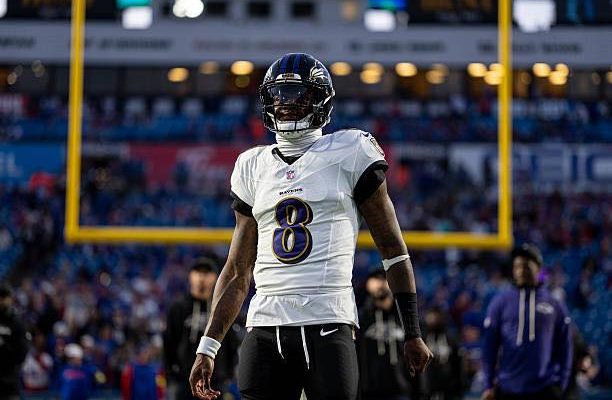Lamar Jackson’s encounter with a Buffalo Bills fan during Sunday night’s game has drawn widespread attention, but the NFL has confirmed that no disciplinary action will be taken against the Ravens quarterback. According to NFL spokesman Brian McCarthy, “the club has addressed the matter and there is no further action from the league.” While the incident sparked discussions across social media and sports networks, league officials have clarified that the situation is being managed internally by the Baltimore Ravens organization and does not warrant league intervention.
The Ravens have emphasized that player safety remains a top priority, with team officials providing reassurance that measures are being taken to prevent similar occurrences in the future. A Ravens spokesperson stated, “The safety of our players is our top priority. We have discussed the event with Lamar, who is aware of the gravity of the situation. We have put in place extra security measures, both at home and on the road, to better protect our players and manage unfavorable fan interactions going forward, even though we will keep internal matters confidential.” The statement reflects the organization’s commitment to maintaining a safe environment for its players while also respecting their privacy in sensitive matters.
The incident occurred during a highly charged matchup against the Buffalo Bills, where emotions ran high both on the field and among the fans. Details surrounding the encounter remain limited, as both the Ravens and the NFL have chosen to handle the situation discreetly. The focus has been on ensuring that Jackson, one of the league’s premier quarterbacks, remains protected from any potential threats posed by overzealous or aggressive spectators. Despite the absence of league fines or suspensions, the incident serves as a reminder of the complex interactions that can occur between players and fans during high-profile games.
Jackson has long been a target of intense scrutiny and passionate fan reactions due to his dynamic playing style and high-profile status in the NFL. As a dual-threat quarterback who has consistently delivered spectacular performances, he naturally draws both admiration and criticism from opposing fans. The high stakes of Sunday night matchups, coupled with the atmosphere of NFL stadiums, can occasionally lead to confrontations, which is why teams like the Ravens invest heavily in security protocols to mitigate risks to their athletes.
In response to the encounter, the Ravens have reportedly taken steps to bolster security measures at M\&T Bank Stadium and during away games. These measures likely include enhanced monitoring of the crowd, the presence of additional security personnel near the sidelines, and more rigorous screening of fan access points. While specific details of these internal procedures are not publicly disclosed, the team’s proactive approach demonstrates a commitment to ensuring that incidents like the one involving Jackson are addressed swiftly and effectively.
Player-fan interactions in the NFL are a delicate balance, as fans are an integral part of the game experience, yet safety concerns remain paramount. Over the years, there have been multiple instances across professional sports where players have been subjected to inappropriate behavior from spectators, prompting organizations to implement stricter safety policies. In Jackson’s case, the Ravens’ immediate response and subsequent security enhancements highlight a growing trend in professional sports toward prioritizing player well-being without creating unnecessary public controversy.
Jackson himself has maintained a professional demeanor throughout the incident. According to Ravens officials, he has been briefed on the situation and understands its seriousness. The team’s communication indicates that while the encounter was significant enough to warrant internal review, it did not escalate to a level that would require public disciplinary measures or fines from the NFL. By handling the matter internally, the Ravens aim to protect their star quarterback while avoiding undue attention that could distract from the team’s on-field performance.
The NFL’s stance on the matter aligns with its broader policy of reviewing incidents case by case, ensuring that player safety and conduct are appropriately managed without overextending league authority into matters that can be effectively resolved at the team level. McCarthy’s statement underscores the league’s confidence in the Ravens’ handling of the situation and reinforces the idea that the NFL views its member organizations as capable of managing these types of events responsibly. This approach allows the league to maintain consistency in its disciplinary actions while recognizing that individual clubs are best positioned to address certain internal security concerns.
Fans of both the Ravens and the Bills have expressed a range of reactions on social media. Some have criticized the fan involved in the encounter, emphasizing that such behavior is unacceptable and can jeopardize player safety. Others have acknowledged the challenges that players face in high-pressure games, where emotions often run high and interactions with spectators are inevitable. The discussion around Jackson’s encounter has sparked broader conversations about fan conduct, stadium security, and the responsibilities of professional sports organizations in preventing similar incidents in the future.
The Ravens’ handling of the situation also sheds light on the evolving nature of player security in the NFL. Teams now operate in an environment where social media amplifies every incident, and where fans are increasingly vocal both in-person and online. By addressing the matter internally and reinforcing security protocols, the Ravens are signaling that they are taking proactive steps to safeguard their players while minimizing distractions. This approach not only protects the athletes but also ensures that the team can maintain focus on competitive performance without unnecessary external controversies.
While the incident itself may not have resulted in league fines, it serves as an important case study for other NFL teams in managing player-fan interactions. Ensuring that security personnel are prepared to respond quickly, that players are educated on how to handle confrontations, and that fans understand acceptable behavior standards are all critical components of maintaining a safe and enjoyable environment at professional sporting events. The Ravens’ response illustrates that a combination of internal protocols, heightened security measures, and clear communication with players can effectively mitigate risks and prevent similar incidents in the future.
Jackson’s encounter with the Bills fan comes at a time when the Ravens are focusing on building momentum in the regular season. Maintaining player health and safety is essential for the team’s aspirations, and ensuring that Jackson is protected both on and off the field is integral to achieving those goals. The organization’s transparent communication regarding internal measures, without revealing sensitive operational details, reflects a strategic balance between accountability and discretion.
In conclusion, Lamar Jackson’s recent interaction with a Buffalo Bills fan has been addressed internally by the Ravens, with no fines or disciplinary actions issued by the NFL. Statements from both the league and team officials highlight the importance of player safety and the measures taken to prevent future incidents. While specific details of the encounter are confidential, the proactive steps taken by the Ravens underscore the significance of security protocols in modern professional sports. Jackson has been briefed on the situation, and the organization has implemented additional security measures to protect its players at home and on the road. The incident serves as a reminder of the challenges athletes face in high-profile games and the essential role that teams and leagues play in ensuring their safety, allowing players like Jackson to focus on performance without undue distractions or risk. The broader conversation about fan conduct and stadium security continues to be relevant, with this case illustrating how professional sports organizations can handle potentially volatile situations effectively, responsibly, and discreetly.
The incident has also sparked discussion about broader issues regarding fan behavior in the NFL. Fans attending games are expected to adhere to conduct policies designed to maintain safety and sportsmanship, but lapses inevitably occur. This situation reinforces the ongoing need for clear boundaries, vigilance from security personnel, and swift internal action when breaches occur. While Jackson’s encounter did not lead to public sanctions, it highlights the delicate balance teams must strike between ensuring safety, respecting fan engagement, and protecting player well-being. The Ravens’ measured and confidential approach demonstrates how a professional sports organization can address these challenges while maintaining focus on competitive performance, setting a precedent for handling similar events across the league.
Overall, Lamar Jackson’s experience underscores the importance of proactive measures in professional sports to safeguard athletes, the effectiveness of internal team protocols, and the NFL’s reliance on teams to manage specific incidents responsibly. While the encounter may have caused temporary headlines and sparked debate among fans, the lack of fines or league action shows confidence in the Ravens’ handling and a commitment to prioritizing the safety of players without escalating unnecessary controversy. This episode will likely serve as a reference point for teams and the league in developing strategies to manage fan interactions and enhance security, ensuring that athletes like Jackson can continue to perform at the highest level in a safe and controlled environment.
The response by both the Ravens and the NFL also provides a glimpse into how professional sports organizations balance transparency and confidentiality. By acknowledging the incident publicly while keeping operational details private, the Ravens strike a balance that reassures the public about player safety while protecting sensitive security protocols. This measured approach demonstrates the importance of strategic communication in high-profile incidents, particularly when they involve star players whose actions and experiences are highly visible to fans and media alike.
As NFL teams continue to navigate the complexities of fan engagement, player safety, and media scrutiny, incidents like Lamar Jackson’s encounter with a Bills fan serve as reminders of the ongoing challenges in professional sports. Teams must remain vigilant, implement effective security measures, and communicate appropriately to ensure player safety without creating unnecessary controversy. Jackson’s situation shows that even high-profile incidents can be managed effectively through internal measures, highlighting the critical role of team protocols and leadership in maintaining a secure and professional sporting environment.
Ultimately, the episode reinforces the NFL’s position that while fan interactions are an inevitable part of the game, player safety must remain paramount. The Ravens’ swift and confidential handling, coupled with enhanced security measures, provides a model for other organizations facing similar situations. Jackson can now continue focusing on his performance, confident in the knowledge that his team is proactively managing risks, and the league can maintain its oversight without overstepping, demonstrating a collaborative approach to maintaining professionalism and safety in the NFL.
This approach not only protects players but also ensures the integrity of the game, allowing fans to enjoy live sports without compromising safety. Jackson’s encounter, while troubling in the moment, underscores the importance of robust internal security procedures, proactive team intervention, and strategic communication between the league and its member organizations. The Ravens’ response and the NFL’s decision not to impose fines reflect a shared commitment to prioritizing player safety while maintaining discretion, professionalism, and operational effectiveness in managing high-profile incidents.
As the NFL season progresses, both teams and the league will likely continue to refine their approaches to player security, learning from incidents like the one involving Lamar Jackson. The focus will remain on creating safe environments that allow players to compete at the highest level, ensuring that fans can engage with the game responsibly, and reinforcing the accountability of teams in managing internal matters effectively. Jackson’s experience serves as a practical example of how professional sports organizations can address potentially volatile situations while preserving the integrity of the game and protecting their most valuable assets—the players themselves.
The broader implications of this incident suggest that as the league grows and fan engagement intensifies, teams must remain vigilant and adaptable in their security strategies. Jackson’s situation highlights that even without league-imposed penalties, incidents involving player safety require thoughtful internal management, clear communication, and proactive measures to prevent recurrence. By taking these steps, the Ravens and other teams can ensure that players are able to perform without unnecessary distractions, fans understand the boundaries of acceptable behavior, and the league maintains a safe, competitive, and professional environment across all venues.
In sum, Lamar Jackson’s encounter with a Bills fan illustrates the importance of internal team protocols, proactive security measures, and effective communication in managing player safety incidents. The Ravens’ handling of the matter, coupled with the NFL’s acknowledgment that no fines are necessary, reflects a collaborative approach that prioritizes athlete protection while maintaining operational discretion. Jackson can continue his season with confidence in his team’s ability to manage such incidents, and the league can rely on its member organizations to handle similar situations responsibly. This incident serves as a reminder of the ongoing need for vigilance, professionalism, and strategic planning in maintaining the safety and integrity of professional sports.
The Ravens’ actions and the league’s stance collectively demonstrate that player safety is an ongoing concern that requires both proactive measures and careful management. Jackson’s encounter has provided a case study in how to balance transparency, discretion, and security, offering lessons for other teams and leagues in maintaining a safe environment for athletes. By addressing the situation internally, reinforcing security protocols, and communicating effectively with players and the public, the Ravens have showcased a thoughtful and comprehensive approach to player protection, ensuring that star athletes like Lamar Jackson can continue to excel on the field while minimizing exposure to potential risks.
The incident also emphasizes the critical role of team leadership in managing such situations. Coaches, security personnel, and administrative staff must coordinate effectively to ensure that players are protected, that any potential threats are mitigated, and that communication with both the public and the league is clear and appropriate. Jackson’s experience highlights the need for ongoing training, preparedness, and vigilance in professional sports, demonstrating that even seemingly isolated events can have broader implications for player safety and organizational reputation.
Moving forward, it is likely that the Ravens will continue to refine their security procedures, learning from this encounter to further safeguard their players in stadiums and during travel. By taking a proactive stance, the team not only protects its athletes but also sets an example for other franchises in managing similar incidents. The league, meanwhile, reinforces the principle that teams are equipped to handle internal matters responsibly, ensuring that player safety remains a top priority without necessitating additional punitive measures.
Ultimately, Lamar Jackson’s experience underscores the importance of preparedness, communication, and discretion in professional sports. The Ravens’ internal handling, coupled with enhanced security measures, allows Jackson to remain focused on his performance while providing fans with confidence that their favorite players are safe. The NFL’s decision not to issue fines confirms that the situation has been managed appropriately, highlighting the collaborative responsibility of teams and the league in protecting athletes and maintaining the integrity of the game.
In conclusion, while the incident involving Lamar Jackson and a Bills fan attracted significant attention, it has been resolved internally by the Ravens with no league-imposed fines. The team has implemented additional security measures to ensure player safety, reaffirming their commitment to protecting their athletes in high-pressure game environments. Jackson has been briefed on the situation and understands its seriousness, allowing him to maintain focus on his performance. The NFL has recognized the Ravens’ handling, emphasizing that no further action is necessary. This episode serves as a reminder of the critical importance of proactive security protocols, effective internal communication, and the ongoing commitment of professional sports organizations to safeguard their players while preserving the integrity and enjoyment of the game for all involved.
This comprehensive approach ensures that professional athletes like Lamar Jackson can compete at the highest level while minimizing exposure to potentially harmful situations. The Ravens’ response, in conjunction with the NFL’s acknowledgment, demonstrates a thoughtful and strategic approach to player safety, highlighting best practices in managing high-profile incidents and emphasizing the importance of discretion, preparedness, and proactive security measures in modern professional sports.
In essence, Lamar Jackson’s encounter with a Bills fan illustrates how professional sports organizations can successfully navigate challenging situations involving player safety. By addressing the matter internally, implementing additional protective measures, and maintaining clear communication with both the player and the public, the Ravens have demonstrated a commitment to safeguarding their athletes while preserving the competitive integrity of the NFL. This incident underscores the importance of vigilance, professionalism, and proactive planning in ensuring that players are able to perform at their best in a secure and controlled environment.
The way the Ravens have managed the situation provides a roadmap for other teams in handling similar events, highlighting the importance of balancing transparency with confidentiality, maintaining robust security measures, and prioritizing player safety above all else. Lamar Jackson’s experience serves as a reminder that while high-profile athletes often face unique challenges in their interactions with fans, effective internal protocols and strategic communication can mitigate risks, protect players, and uphold the integrity of the game.
In summary, the incident involving Lamar Jackson and the Bills fan has been effectively addressed internally by the Ravens, with the NFL confirming no fines are necessary. The team’s proactive approach to security, coupled with clear communication with the player, underscores the importance of prioritizing athlete safety while maintaining discretion. Jackson can now focus on his performance, confident in the knowledge that his organization has taken comprehensive steps to protect him. This case serves as a model for other teams and leagues, demonstrating how to manage player-fan interactions responsibly and effectively while preserving the safety, professionalism, and integrity of the sport.
The broader lesson from this incident is that proactive planning, effective security measures, and internal management are crucial in addressing potential threats to player safety. The Ravens’ actions exemplify best practices in professional sports, ensuring that athletes can compete without distraction or risk. Jackson’s experience, while significant, highlights the effectiveness of these measures and the importance of collaborative responsibility between teams and the league. By addressing the matter thoughtfully and discreetly, the Ravens have reinforced the principle that player safety is paramount, while the NFL’s recognition of their handling underscores the effectiveness of internal team protocols in maintaining a safe and professional sporting environment.
In conclusion, Lamar Jackson’s encounter with a Bills fan serves as a clear example of how professional sports organizations can navigate complex situations involving player safety. The Ravens’ proactive response, the implementation of enhanced security measures, and the league’s acknowledgment that no fines are necessary all demonstrate a commitment to protecting athletes while maintaining operational discretion. Jackson can continue his season with confidence, knowing that his team has taken all necessary steps to ensure his safety, while the NFL maintains oversight without overstepping. This incident highlights the importance of vigilance, preparation, and effective internal management in safeguarding players and upholding the integrity of professional sports, offering a model for other teams facing similar challenges in the future.
The event also underscores the ongoing importance of balancing fan engagement with player protection. Stadiums are designed to foster excitement and interaction, but incidents like this remind teams and leagues of the need for constant vigilance and strategic security planning. The Ravens’ approach—handling the matter internally, enhancing protective measures, and communicating effectively—demonstrates a commitment to both player welfare and operational discretion. Jackson’s encounter, resolved without league fines, emphasizes the critical role of thoughtful internal management in ensuring that athletes can perform at the highest level while maintaining a safe environment for all participants.
In the end, Lamar Jackson’s experience reflects broader trends in professional sports where player safety, security protocols, and internal team management intersect. By effectively addressing the incident, implementing additional security measures, and maintaining clear communication with the player, the Ravens have set an example for how teams can responsibly handle such situations. The NFL’s recognition that no fines are necessary further validates the effectiveness of internal protocols and underscores the league’s confidence in teams’ ability to manage player safety issues. This incident serves as a case study in balancing transparency, discretion, and proactive security measures, ensuring that star athletes like Lamar Jackson can focus on their performance without unnecessary distractions or risk.
The Ravens’ handling of the incident also signals to fans the importance of maintaining respectful behavior and adhering to stadium conduct policies. By taking the situation seriously and implementing additional security measures, the team reinforces expectations for appropriate fan behavior while prioritizing the well-being of its players. Jackson’s experience demonstrates how organizations can address potential conflicts effectively, preserving both player safety and fan engagement, and providing a blueprint for other teams in the league.
Ultimately, Lamar Jackson’s encounter with a Bills fan serves as a reminder that player safety remains a top priority in professional sports. The Ravens’ proactive measures, internal handling of the situation, and communication with the player reflect a comprehensive approach to ensuring athlete protection. The NFL’s confirmation that no fines are necessary validates this approach and highlights the effectiveness of team-level management in addressing security concerns. Jackson can now continue his season focused on performance, supported by enhanced protective measures and a team committed to safeguarding its players, illustrating best practices in managing high-profile sports incidents responsibly and effectively.
The incident also underscores the need for ongoing evaluation of security protocols and fan interaction policies across professional sports. By learning from events like Jackson’s encounter, teams can refine their approaches to crowd management, player protection, and emergency response planning. The Ravens’ handling demonstrates how organizations can proactively address potential threats while maintaining discretion and professionalism, ensuring that athletes remain safe and focused on their performance. Jackson’s experience highlights the importance of vigilance, preparation, and internal management in maintaining a secure and controlled environment, setting a standard for other teams to emulate.
In summary,



